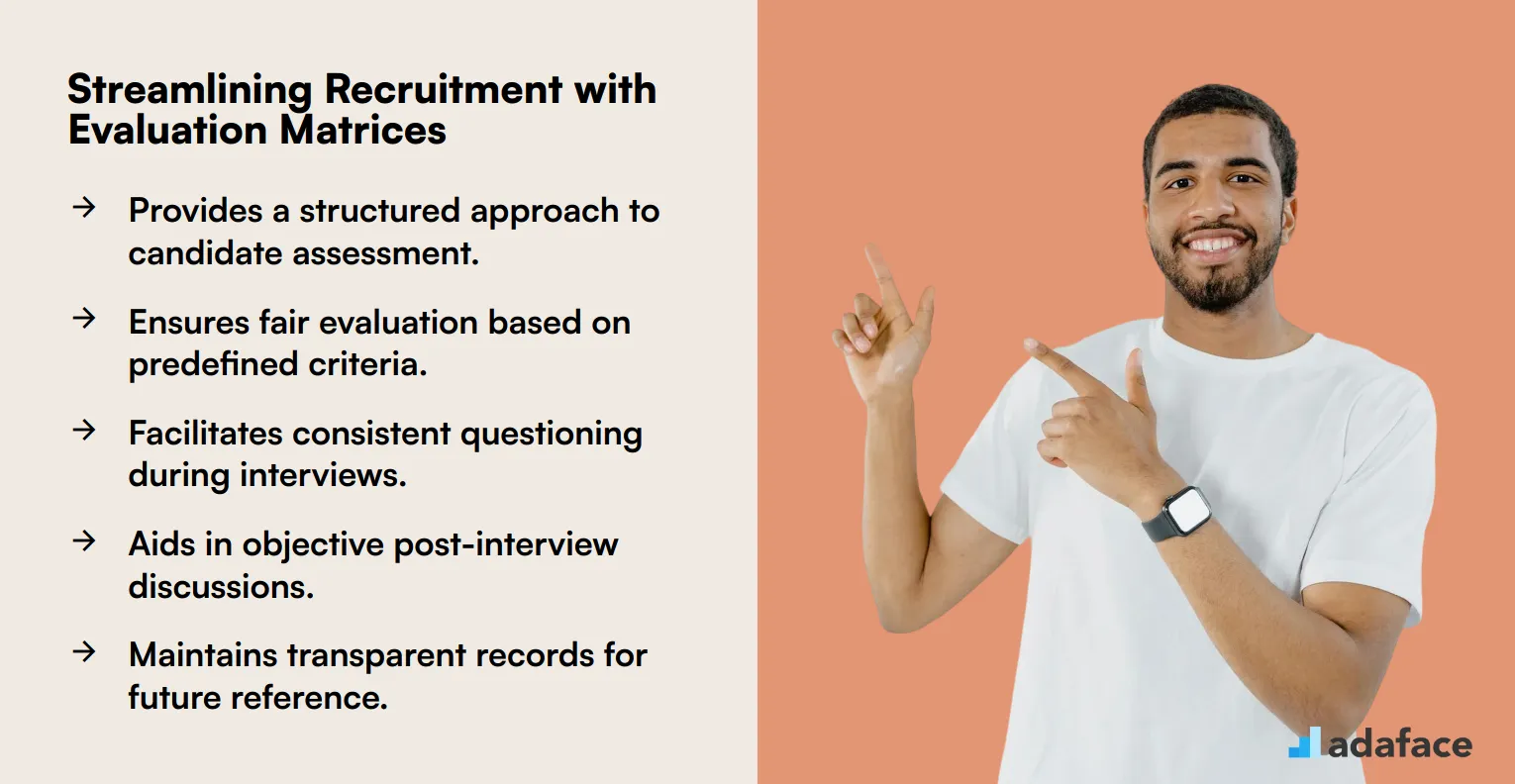Using an evaluation matrix can bring structure and fairness to your hiring process. It's a simple tool that helps recruiters compare candidates based on pre-defined criteria, ensuring a more objective hiring decision.
Think of it as a scorecard for candidates. By using a structured interview process, you can minimize interviewer bias and focus on what truly matters for the role.
Table of contents
What is an Evaluation Matrix?
An evaluation matrix is a structured tool used by recruiters and hiring managers to assess and compare job candidates. It consists of a grid where criteria such as skills, experience, and cultural fit are listed and scored to provide a clear picture of each candidate's strengths and weaknesses.
By using an evaluation matrix, interviewers can make more informed decisions, reducing biases and ensuring a fair assessment process. This tool helps in maintaining consistency across interviews, making it easier to identify the best fit for the role.
Evaluation matrices are particularly useful in high-volume recruiting scenarios, where multiple candidates are assessed for the same position. They allow hiring teams to objectively compare candidates by setting predefined criteria, which can help streamline the selection process.
Incorporating an evaluation matrix into your hiring process can also enhance the overall candidate experience. Candidates appreciate a transparent process where they know the criteria on which they are being judged, leading to higher satisfaction and engagement.
Ultimately, an evaluation matrix serves as a guide for recruiters to make data-driven decisions, improving the quality of hire and aligning candidates with the organization's needs and culture.
Key Components of an Evaluation Matrix
An evaluation matrix is a structured tool that helps recruiters and hiring managers assess candidates systematically. It ensures that the recruitment process is fair, transparent, and aligned with the organization's goals.
One key component of an evaluation matrix is the criteria used for assessment. These criteria should be directly related to the job description and include both technical and soft skills necessary for the role.
Another essential element is the weightage assigned to each criterion. This helps prioritize certain skills or attributes over others, ensuring alignment with the company's strategic objectives.
The rating scale is also a crucial part of the matrix. It provides a standardized way to score candidates, which aids in comparing different applicants objectively.
Lastly, the matrix should include a section for comments or notes. This allows interviewers to provide qualitative feedback that can be valuable for final decision-making.
Using an evaluation matrix can enhance the overall recruitment process by promoting structured interviews, reducing bias, and improving the quality of hire.
Creating an Effective Evaluation Matrix
Creating an effective evaluation matrix begins with clearly defining the job requirements and the skills necessary for success in that role. This step ensures that the matrix aligns with the specific needs of the position and the organization's broader goals.
Next, identify the key competencies and attributes that candidates must possess, such as communication skills or problem-solving abilities. These elements will serve as the foundation for evaluating each candidate's suitability for the role.
Develop a scoring system that quantifies each candidate's performance across these competencies. This system should be simple yet comprehensive enough to provide a clear picture of each candidate's strengths and areas for improvement.
Incorporate feedback from multiple evaluators to ensure a balanced and unbiased assessment. This approach minimizes individual biases and provides a more holistic view of each candidate's potential.
Finally, regularly review and update the evaluation matrix to keep it relevant and aligned with evolving industry standards and organizational needs. This ongoing refinement will help maintain the effectiveness of your recruitment process and support your long-term talent acquisition goals.
Using the Matrix During Interviews
Using an evaluation matrix during interviews can streamline the selection process by providing a structured approach to assess candidates. It helps interviewers compare applicants objectively, ensuring a fair assessment based on predefined criteria.
Recruiters and hiring managers can customize the matrix to focus on skills and qualities most relevant to the job role. This tailored approach allows for a more accurate evaluation of each candidate's fit for the position, enhancing the quality of hire.
During interviews, the matrix serves as a guide to ask consistent questions and record responses systematically. This consistency minimizes interviewer bias, leading to more reliable hiring decisions and a better candidate experience.
The matrix also facilitates post-interview discussions among hiring team members. It provides a visual representation of candidate strengths and weaknesses, aiding in reaching a consensus on the best candidate.
Furthermore, using an evaluation matrix helps in maintaining a record of the assessment process. This documentation is useful for future reference and ensures transparency in the recruitment process.

Common Pitfalls to Avoid
When using an evaluation matrix, one common pitfall is overcomplicating the criteria, which can lead to confusion and inefficiencies. It's crucial to keep the criteria straightforward and relevant to the role to ensure a seamless hiring process.
Another mistake is failing to update the matrix regularly, which can result in outdated or irrelevant criteria. Regularly reviewing and revising the matrix ensures it aligns with the current needs and goals of your organization.
Bias is another significant pitfall that can skew the results and lead to poor hiring decisions. Implementing strategies to minimize bias, such as structured interviews, can help maintain fairness and objectivity.
Ignoring the feedback from interviewers using the matrix can also be detrimental. Gathering and incorporating feedback can enhance the effectiveness of the evaluation matrix and improve the overall recruitment process.
Lastly, relying solely on the matrix without considering other factors like cultural fit or soft skills can lead to hiring the wrong candidate. Balancing the matrix with a holistic view of the candidate ensures a more comprehensive evaluation.
Adapting the Matrix for Different Roles
Adapting the evaluation matrix for different roles requires understanding the unique requirements and expectations of each position. Recruiters and hiring managers must tailor the matrix to focus on specific skills and competencies relevant to the role, ensuring a fair assessment of candidates.
For technical positions, the matrix might emphasize problem-solving abilities and domain-specific knowledge. This could involve integrating technical screening tools to better assess a candidate's proficiency in required technologies.
In contrast, roles that prioritize interpersonal skills, like sales or customer service, may require a matrix that highlights communication and empathy. Behavioral interviews and role-playing scenarios can be incorporated to evaluate these soft skills effectively.
Leadership roles demand a focus on strategic thinking and decision-making capabilities. The matrix can include assessments like case interviews or situational judgment tests to gauge these competencies.
For creative roles, the evaluation matrix should prioritize innovation and originality. Portfolio reviews and creative problem-solving tasks can be part of the assessment to ensure candidates align with the company's creative vision.
Conclusion
Evaluation Matrix FAQs
An evaluation matrix promotes objectivity, consistency, and transparency in the hiring process. It helps recruiters focus on key qualifications and skills, leading to better hiring decisions.
Start with the job description and identify the most important skills, experience, and competencies. Involve hiring managers to ensure alignment with the role's requirements.
Yes, the evaluation matrix should be tailored to each specific role. Adjust the criteria and weighting to reflect the unique requirements of the position.
Define clear and measurable criteria. Train interviewers to avoid subjective judgments and focus on evidence-based assessments. Also, consider blind resume screening.
A skills matrix is a tool for identifying and assessing the skills of current employees. An evaluation matrix is used during the hiring process to compare candidates based on predefined criteria.
Consider additional factors, such as cultural fit, team dynamics, or long-term potential. You can also conduct a second interview or use a job simulation to further assess their capabilities.

40 min skill tests.
No trick questions.
Accurate shortlisting.
We make it easy for you to find the best candidates in your pipeline with a 40 min skills test.
Try for freeRelated terms



